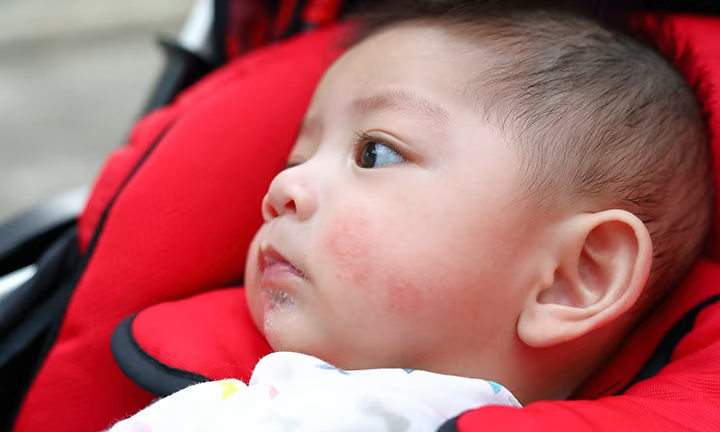
All About Teething Rash: Treatment and Prevention
Babies often dribble, especially when teething. Sometimes the excess saliva can cause a harmless rash around the mouth or on the chin that’s referred to as a teething rash or drool rash.
Find out what causes baby teething rash, what teething rash treatment is recommended and how you can help prevent drool rash.
What Is Teething Rash
Teething rash (also known as drool rash) is a rash on the face caused by saliva. It can be mildly uncomfortable for your baby but isn’t a cause for concern – and there’s plenty you can do to soothe and protect your little one’s sore, irritated skin.
What Causes Teething Rash?
The skin around your baby’s mouth and/or chin may become inflamed and irritated when excess saliva dribbles down and stays on the skin for prolonged periods. Although it can happen at other times too, this kind of rash is usually associated with teething because babies often dribble more than usual when a new tooth is pushing through.
What Does Teething Rash Look Like?
A drool rash may appear as a red, inflamed rash. It can be itchy and sore. The skin may also appear cracked and dry in places, especially at the corners of the mouth.
At What Age Does Teething Rash Typically Develop?
Drool rash typically develops from the time your baby is a newborn into toddlerhood.
Excess dribbling is common between the ages of 4 and 6 months, which is around the time when teething may start for some babies, although some may start earlier or later than this.
As teething continues, excess saliva may cause a drool rash if it stays on your baby’s skin for prolonged periods and irritates your baby’s skin.
What Helps Teething Rash?
The best way to ease a teething rash is to keep the area as dry as possible to prevent further irritation and allow your baby’s skin to heal naturally. Gently applying a little petroleum jelly to the affected area before going outside can protect against the weather. You can do the same before putting your baby to bed.
Never apply any creams or ointments to cracked or bleeding skin without first asking your doctor.
How Can You Prevent Teething Rash?
Preventing teething rash is simple, but it can take some patience if your baby seems to be producing an endless stream of dribble. Gently wipe or dab away the dribble to keep your infant’s mouth area as dry as possible.
It’s important not to rub or wipe too hard, as this can make the irritation worse.
Does Breast Milk Help Drool Rash?
Yes! Breast milk has antibacterial properties, and it also stimulates the release of enzymes in your baby’s dribble, so it can help guard against certain germs that may cause infections. Breastfeeding can also boost your baby’s immune system.
Does Teething Rash Hurt?
A teething rash can be uncomfortable for your baby, causing soreness or itching, but it’s not infectious or life-threatening. If your child is teething, this may be adding to your little one’s discomfort. As your doctor about pain relief if you think it may be necessary.
Is It Drool Rash or Eczema?
You might be unsure whether your baby has a simple teething rash or eczema, which can also appear as red, dry patches of skin.
This is a natural question to ask, as teething rash and eczema are both forms of dermatitis, a condition where the skin becomes dry and irritated. In fact, the word eczema and dermatitis mean the same thing.
The two main types of dermatitis are:
So, in essence, drool rash is also a form of eczema. The difference between atopic dermatitis (atopic eczema) and contact dermatitis (such as drool rash) is that atopic eczema is usually a chronic condition that needs to be managed over the long term, while contact dermatitis clears up if you remove the source of the irritation.
When Should You See a Doctor?
A teething rash should be easy to treat. If the symptoms don’t start to go away within a day or two after you start keeping your little one’s mouth area free of dribble – and/or if you notice any other symptoms apart from the rash – it’s worth investigating whether your baby has some other childhood rash.
See your baby’s doctor straight away if the teething rash
Call 999 or visit A&E immediately if your baby has any of these symptoms. They could be signs of meningitis, which needs urgent treatment:
The Bottom Line
Teething rash or drool rash is a harmless rash that can happen from time to time. To prevent teething rash from developing or worsening, keep your baby’s mouth area and chin as dribble-free as possible and use a bib to catch and absorb any excess saliva. Applying a little petroleum jelly can also help protect the skin, especially during the night or outdoors.
A teething rash may be uncomfortable for your baby but it’s usually not anything to be worried about. Before long, your baby’s skin will be as soft and kissable as before!
The information in this article is based on the expert advice found in trusted medical and government sources, such as the National Health Service (NHS). You can find a full list of sources used for this article below. The content on this page should not replace professional medical advice. Always consult medical professionals for full diagnosis and treatment.
Read more about Baby
Related Articles
Join Pampers Club and get:






